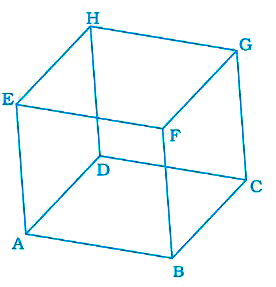In Figure, name the face parallel to BFGC faces adjacent to BFGC three edges which meet in the vertex G.
Step by step video & image solution for In Figure, name the face parallel to B F G C faces adjacent to B F G C three edges which meet in the vertex Gdot by Maths experts to help you in doubts & scoring excellent marks in Class 6 exams.
Topper's Solved these Questions
Similar Questions
In Figure, name the face parallel to BFGC faces adjacent to BFGC three edges which meet in the vertex G.
View SolutionFor the cuboid show in Figure. What is the base of this cuboid? What are the lateral faces of this cuboid? Name one pair of opposite faces. How many pairs of opposite faces are there? Name them. Name all the faces of this cuboid which have X as a vertex. Also, name those which have VW as a side. Name the edges of this cuboid which meet at the vertex P. Also, name those faces which meet at this vertex.
View Solution
Knowledge Check
- Question 1 - Select One
The six faces of a dice have been marked with the letters A, B, C, D, E and F. If A is adjacent to B, C and E, then which of the following statements is true?
AA is adjacent to D .BA is adjacent to FCB is adjacent to F .DD is adjacent to F . - Question 2 - Select One
DIRECTIONS: Study the following information and answer the questions given:
Seven people – A, B, C, D, E, F and G are sitting in a circle. Five of them are facing the centre while two of them are facing opposite to the centre. C sits third to the left of D and both are facing the centre. E is neither an immediate neighbour of D nor of C. The one sitting exactly between D and F is facing opposite to the centre. G sits third to the right of A and G is facing the centre. One of B's neighbour is facing opposite to the centre.
Which of the following pair represents persons, facing opposite to the centre?AE, FBA, FCCannot be determinedDA, E - Question 3 - Select One
Six faces of the dice are A, B, C, D. E and F. A is adjacent to B. B is adjacent to D but not C. E is adjacent to D and F. What is the side opposite to A?
ACBDCEDF
Eight persons A, B, C, D, E, F, G and H are seated around a circular table facing the centre. C and E are not adjacent to each other. B is on the left of E. H is on the right of D. There are three persons between B and H. A is adjacent to F. F is on the left of C.
Which of the following statements is true?
1) C is second to the right of E.
2) A is on the immediate right of F.
3) E is on the immediate left of D.
4) B is on the immediate right of C.
5) None of theseView SolutionEight persons A, B, C, D, E, F, G and H are seated around a circular table facing the centre. C and E are not adjacent to each other. B is on the left of E. H is on the right of D. There are three persons between B and H. A is adjacent to F. F is on the left of C. question:
Assuming A to be at the first position and moving clockwise, who occupies the sixth position?
1) B
2) G
3) C
4) Can’t be determined
5) None of theseView SolutionEight persons A, B, C, D, E, F, G and H are seated around a circular table facing the centre. C and E are not adjacent to each other. B is on the immediate left of E. H is on the immediate right of D. There are three persons between B and H. A is adjacent to F. F is on the immediate left of C.
If each person interchanges his or her position with the person seated opposite, who will be on the right of D?
1) E
2) F
3) G
4) D
5) None of theseView SolutionEight persons A, B, C, D, E, F, G and H are seated around a circular table facing the centre. C and E are not adjacent to each other. B is on the immediate left of E. H is on the immediate right of D. There are three persons between B and H. A is adjacent to F. F is on the immediate left of C.
Which of the following is an incorrect pair of persons seated opposite each other?
1) EA
2) DC
3) BA
4) Can’t be determined
5) None of theseView SolutionIn the figure of cube.
(i) Which edge is the intersection of faces EFGH and EFBA?
(ii) Which faces intersect at edge FB?
(iii) Which three faces form the vertex A?
(iv) Which vertex is formed by the faces ABCD, ADHE and CDHG?
(v) Give all the eges that are parallel to edge AB.
(vi) Give the eges that are neither parallel nor perpendicular to edge BC.
(vii) Give all the edges that are perpendicular to edge AB.
(viii) Give four vertices that do not all lie in one plane.
 View Solution
View Solution

